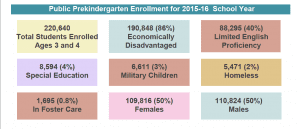
COVID-19 & Education: We Should Tie School Funding to Enrollment
Texas is responsible for educating nearly 5.4 million school-age children. However, our school finance system leaves nearly 4.3% — or 262,000 students — unfunded, which is
Helping kids start school ready to learn is one of the best ways to ensure all Texans have the chance to compete and succeed in life. Texas has long recognized the value of early education, and since 1985 has offered a state-supported Pre-K program. The goal of the program is to develop math, language and social skills for students from low-income families, with limited English-proficiency, experiencing homelessness or in the foster care system. While access to pre-K has increased over time to include children who lost a parent during military service or as a first responder, the funding necessary to provide high-quality early education has not always been available.


The primary source of Pre-K funding is through the Foundation School Program, the formulas and laws used to fund the maintenance and operation of Texas schools. School districts receive state funding for a half-day instruction, meaning about four hours a day of Pre-K. In 2019, the legislature mandated that every district provide a full-day of Pre-K instruction for four-year-old students. However, funding remains at half-day levels.
Instead of directly funding full-day Pre-K, lawmakers established the Early Childhood Education Allotment. With this allotment, schools have the flexibility to invest in strategies that will improve third grade reading and math outcomes, including full-day Pre-K. School districts will not be required to fund full-day Pre-K with the extra funding.
Every Texan supports and advocates for additional funding for student groups that need additional assistance, but Pre-K students in a full-day program should simply be counted as a full-day student, like students in every other grade. To keep the gains made in Pre-K, students need to transfer into a high-quality kindergarten through third grade environment. Instead of asking school districts to use the Early Education Allotment to fund full-day Pre-K, lawmakers should require those funds be used to support the academic advancement of the student in the grades that generate the funding.

Director of Policy & Advocacy

Director of Economic Opportunity

Texas is responsible for educating nearly 5.4 million school-age children. However, our school finance system leaves nearly 4.3% — or 262,000 students — unfunded, which is

This blog post was written by Communications Intern Bianca Lopez. It’s been seven years since the Texas Legislature made deep budget cuts to public education,

One of the most effective ways we can help kids compete and succeed in life is to make sure they are ready to start Kindergarten.

The annually released rankings of state-supported Pre-K programs by the National Institute for Early Education Research (NIEER) once again show that Texas ranks last in